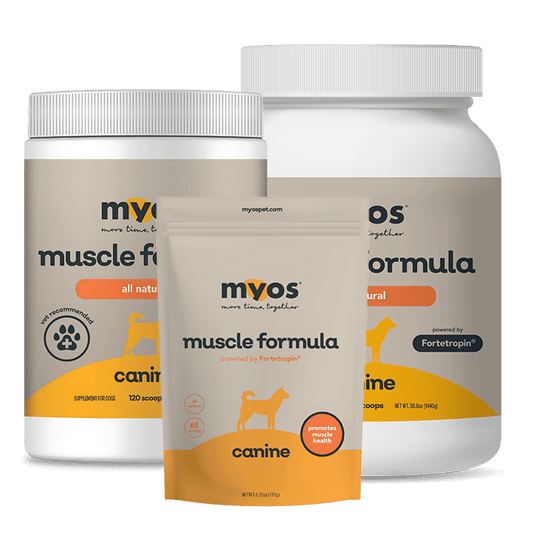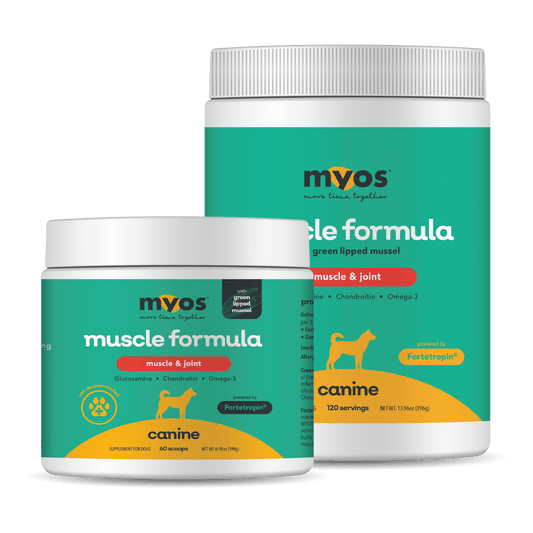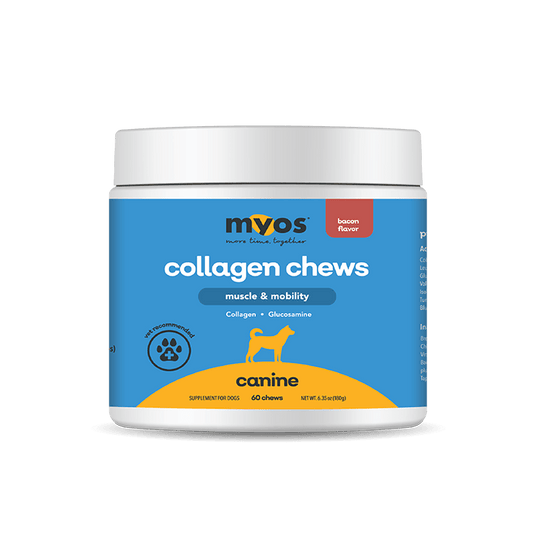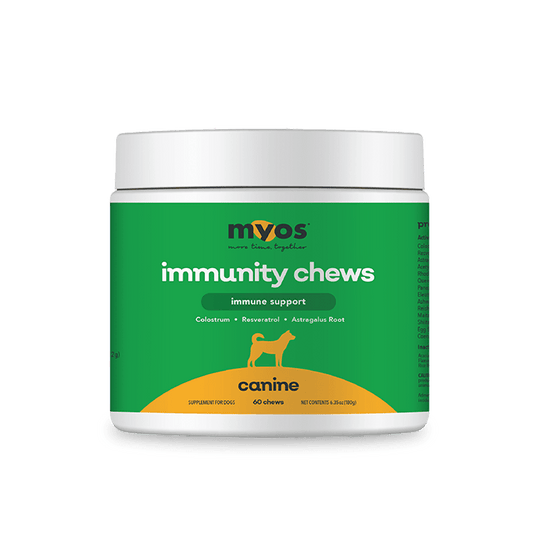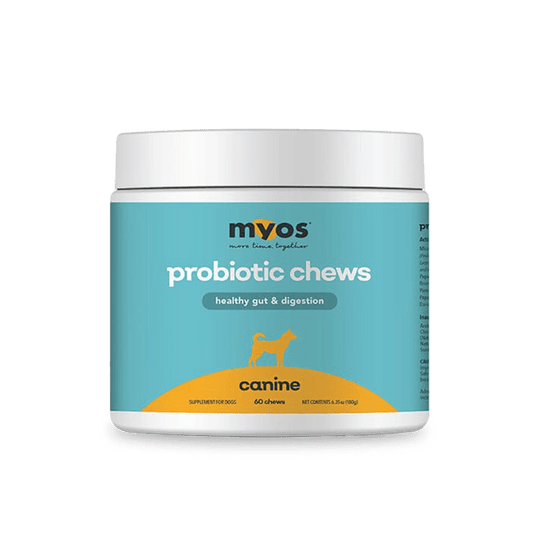Fortetropin®, Vitamin D and Immune Health
By Neerav D. Padliya, Ph.D.
Introduction
Eggs are a rich source of Vitamin D [1,2], an essential nutrient for both man and man’s best friend. According to data published by the U.S. National Institute of Health (NIH), one large egg provides 44 International Units (IU) (1.1 micrograms) of Vitamin D which accounts for 6% of the daily value (DV) of this essential nutrient. However, the story does not end there. In addition to Vitamin D, many animal-based foods such as eggs also contain 25-hydroxyvitamin D [25(OH)D], an important metabolite of Vitamin D. NIH researchers have suggested that 25(OH)D also makes an important contribution to Vitamin D status [2]. When recalculations were performed based on 25(OH)D, it was reported that consuming one large egg has the potential to meet about one-fifth of the estimated average requirement (EAR) for Vitamin D for men. The most well-known function of Vitamin D relates to calcium absorption which plays a vital role in maintaining good bone health [3]. Increasingly, it has become well recognized that Vitamin D plays an important role in muscle health [4-6]. One essential function of Vitamin D that is less well known than muscle and bone homeostasis is related to the impact that Vitamin D has on the healthy functioning of the immune system [7]. In this blog post, we will discuss the potential of the egg yolk-derived nutrition product, Fortetropin to improve Vitamin D status in dogs. We will also discuss in detail, a veterinary clinical trial that was conducted by researchers at Cornell University that focused on dogs diagnosed with immune mediated diseases (IMDs) [8].
What is Fortetropin?
Fortetropin is a nutrition product that is produced from 100% fertilized chicken egg yolk, a natural source of Vitamin D. Vitamin D refers to a family of fat-soluble prohormones that play a vital role in the maintenance of several organ systems. The two major forms of Vitamin D are Vitamin D2 (Ergocalciferol) are Vitamin D3 (Cholecalciferol).

Figure 1: The chemical structure of Vitamin D2. Reproduced from Wikipedia. https://en.wikipedia.org/wiki/Ergocalciferol#/media/File:Ergocalciferol.svg

Figure 2: The chemical structure of Vitamin D3. Reproduced from Wikipedia. https://en.wikipedia.org/wiki/Cholecalciferol#/media/File:Cholecalciferol.svg
Egg yolk powder products typically employ heating during the steps of pasteurization and drying. When egg yolk is heated, many irreversible biochemical changes typically occur which include protein denaturation and lipid oxidation. Researchers at the Technical University of Denmark demonstrated that when eggs are fried or boiled, significant loss of Vitamin D activity results [9]. Fortetropin is manufactured from fertilized, chicken egg yolk by employing a patented [10-12] low temperature manufacturing process that preserves the biological activity of the biomolecules found within egg yolk. An alternative to consuming Fortetropin or cooked eggs is to consume raw eggs. Feeding raw eggs to cats and dogs is very dangerous due to the high possibility of contamination from dangerous pathogens such as Salmonella and Listeria monocytogenes.
Impact of Vitamin D on Immune Function in Dogs
In 2019, researchers at Cornell University published results [8] from a clinical trial that was designed to address the following question: are reduced levels of the Vitamin D metabolites, 25(OH)D3 and 1,25(OH)2D3 associated with poorer outcomes in dogs with immune mediated diseases? Many cells of the immune system metabolize different forms of Vitamin D. Further, many of these immune cells also express the Vitamin D receptor (VDR) which highlights the important role that Vitamin D metabolism plays in the normal functioning of the immune system. An active metabolite of Vitamin D3 known as calcitriol (1,25-dihydroxycholecalciferol) has the most profound impact on the immune system.

Figure 3: The chemical structure of calcitriol (1,25-dihydroxycholecalciferol). Reproduced from Wikipedia. https://en.wikipedia.org/wiki/Calcitriol#/media/File:Calcitriol.svg
Calcitriol plays an important role in driving the differentiation and maturation of regulatory T cells (Tregs) upon binding to and activating VDR. VDR activation reduces the production of the pro-inflammatory cytokines, IL-2 and IFNγ. In addition, VDR activation reduces the production of CXCL10, an IFN-induced leukocyte chemokine. Beyond its chemotactic activity, CXCL10 plays a role in initiating and maintaining pathologic Th1 biased responses. One of the important aspects of the study published by the Cornell researchers was that they examined the impact of CXCL10 status on the survival of dogs with immune mediated diseases. Given the role that VDR activation plays in CXCL10 synthesis, it was hypothesized that dogs with IMDs would have reduced serum levels of Vitamin D metabolites and elevated levels of the chemokine, CXCL10.
The Cornell research group recruited 29 dogs diagnosed with IMDs to participate in the clinical trial in addition to 9 dogs to be part of the control group. Serum Vitamin D metabolites were measured using an LC-MS/MS assay and CXCL10 measurements were based on an ELISA assay. It is apparent from Figure 4 that dogs suffering from IMDs had lower serum concentrations of the Vitamin D metabolites, 25-hydroxyvitamin D3 [25(OH)D3] and 1,25-dihydroxyvitamin D3 [1,25(OH)D3] when compared with dogs in the healthy control group.

Figure 4: (A) A plot of 25-hydroxyvitamin D3 [25(OH)D3] concentrations in the control (CON) and immune mediated diseases (IMD) groups. (B) A plot of 1,25-dihydroxyvitamin D3 [1,25(OH)D3] concentrations in the control (CON) and immune mediated diseases (IMD) groups. Reproduced from [8] which appears as part of Figure 1. https://www.frontiersin.org/articles/10.3389/fvets.2019.00247/full#F1

Figure 5: (A) A plot of serum CXCL10 concentrations in the control (CON) and immune mediated diseases (IMD) groups. (B) A plot of serum CXCL10 concentrations in the IMD group classified according to specific diseases based on the following color scheme: red = immune-mediated hemolytic anemia and thrombocytopenia combined, black = cutaneous/vasculitis disease, blue = pancytopenia. Reproduced from [8] which appears as part of Figure 2. https://www.frontiersin.org/articles/10.3389/fvets.2019.00247/full#F1
When the researchers measured CXCL10 concentrations in dogs in the control and IMD groups, they observed that the median CXCL10 concentration was approximately 30-fold higher in dogs belonging to the IMD group with respect to dogs in the healthy control group (CON) as illustrated in Figure 5. Five dogs were found to have concentrations of CXCL10 that were so high, they exceeded the upper limit of quantification of the ELISA-based assay. Four of these aforementioned dogs were diagnosed with immune-mediated polyarthritis (IMPA) and one dog was diagnosed with immune-mediated hemolytic anemia (IMHA).
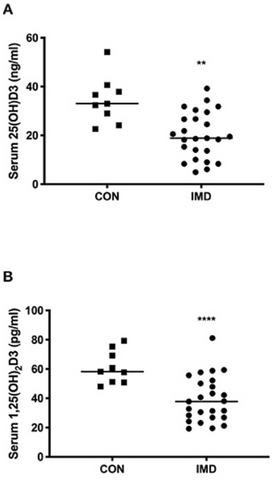
Figure 6: (A) A plot of survival percentage based on high (>median) (HI) and low (<median) (LO) 25(OH)D3 serum concentration. (B) A plot of survival percentage based on high (>median) (HI) and low (<median) (LO) CXCL10 serum concentration. Reproduced from [8] which appears as part of Figure 3.
The most notable aspects of the study were the correlations between (a) Vitamin D status and survival and (b) CXCL10 status and survival. Dogs with serum concentrations of the Vitamin D metabolite, 25(OH)D3 in the lower half had much poorer survival relative to dogs with serum concentrations of 25(OH)D3 that were in the upper half (Figure 6A). Further, dogs with serum concentrations of CXCL10 in the upper half had much poorer survival relative to dogs with serum concentrations of 25(OH)D3 that were in the lower half (Figure 6B).
Fortetropin: A Possible Role for Vitamin D in Attenuating Inflammation and Muscle Atrophy
The inflammatory response of the immune system plays an important role in muscle atrophy [13]. Nutritional supplements with anti-inflammatory properties such as omega-3 fatty acids [14], krill [15], and resveratrol [16] have been shown to attenuate muscle atrophy in dogs in veterinary clinical trials. Comprised of 100% fertilized egg yolk and manufactured using a proprietary, low temperature process, Fortetropin is a rich source of Vitamin D. Multiple studies have shown that a reduced serum concentration of Vitamin D metabolites is associated with an elevated inflammatory state [8, 17-18].
Performed to repair tears of the CCL, tibial plateau leveling osteotomy (TPLO) is one of the most common veterinary surgical procedures in the United States. After TPLO surgery, the operated limb typically requires immobilization for about 8 weeks, resulting in significant disuse muscle atrophy. Veterinary surgeons and researchers at Kansas State University studied the impact of Fortetropin on muscle disuse atrophy in 100 dogs recovering from TPLO surgery [19]. A group of 50 dogs were supplemented with Fortetropin after undergoing TPLO surgery while another group of 50 dogs received supplementation with a macronutrient-matched placebo, cheese powder, following their procedure. The research group at Kansas State University observed that the dogs that received Fortetropin supplementation following TPLO surgery did not experience statistically significant decreases in quadriceps muscle thickness in the affected (p=0.31) and unaffected limb (p=0.37). On the other hand, dogs that received a macronutrient matched placebo did experience losses in muscle thickness after TPLO surgery in the affected (p=0.03) and unaffected limb (p=0.02).
Although the study conducted at Kansas State University did not include any data related to the molecular mechanism of action of Fortetropin, it is possible that an elevation in Vitamin D status may have played some role in reducing inflammation and muscle atrophy. Previous mechanistic studies in rodents conducted by Sharp et al. [20] demonstrated that Fortetropin upregulates mTor pathway activity, downregulates ubiquitin proteasome pathway activity and reduces serum concentrations of myostatin.
Summary
Made from 100% fertilized egg yolk, it is expected that Fortetropin supplementation will lead to improvements in Vitamin D status. Vitamin D is an essential nutrient that plays an important role in bone and muscle health and is essential for the proper functioning of the immune system.
References
- Vitamin D: Fact Sheet For Health Professionals. National Institutes of Health, Office of Dietary Supplements. https://ods.od.nih.gov/factsheets/VitaminD-HealthProfessional/#en20
- Taylor, Christine L., et al. "Including food 25-hydroxyvitamin D in intake estimates may reduce the discrepancy between dietary and serum measures of vitamin D status." The Journal of nutrition144.5 (2014): 654-659.
- Holick, Michael F. "Vitamin D and bone health." The Journal of nutrition126.suppl_4 (1996): 1159S-1164S.
- Pfeifer, M., B. Begerow, and H. W. Minne. "Vitamin D and muscle function." Osteoporosis International13.3 (2002): 187-194.
- Bischoff-Ferrari, Heike A. "Relevance of vitamin D in muscle health." Reviews in Endocrine and Metabolic Disorders13.1 (2012): 71-77.
- Hamilton, B. "Vitamin D and human skeletal muscle." Scandinavian journal of medicine & science in sports20.2 (2010): 182-190.
- Aranow, Cynthia. "Vitamin D and the immune system." Journal of investigative medicine59.6 (2011): 881-886.
- Mick, Phillip J., Seth A. Peng, and John P. Loftus. "Serum vitamin D metabolites and CXCL10 concentrations associate with survival in dogs with immune mediated disease." Frontiers in veterinary science6 (2019): 247.
- Jakobsen, Jette, and Pia Knuthsen. "Stability of vitamin D in foodstuffs during cooking." Food chemistry148 (2014): 170-175.
- Buxmann, W., Heinz, V., Toepfl, S. Process for producing a composition for increasing muscle mass. U.S. Patent # 11,051,524 B2. Issue date: July 6, 2021.
- Buxmann, W., Heinz, V., Toepfl, S. Process for producing a composition for increasing muscle mass. U.S. Patent # 10,165,785. Issue date: January 1, 2019.
- Buxmann, W., Heinz, V., Toepfl, S. Process for producing a composition containing active follistatin. U.S. Patent # 8,815,320. Issue date: August 26, 2014.
- Dalle, Sebastiaan, Lenka Rossmeislova, and Katrien Koppo. "The role of inflammation in age-related sarcopenia." Frontiers in physiology8 (2017): 1045.
- Freeman, Lisa M., et al. "Nutritional alterations and the effect of fish oil supplementation in dogs with heart failure." Journal of Veterinary Internal Medicine12.6 (1998): 440-448.
- Burri, Lena, et al. "Effects of dietary supplementation with krill meal on serum pro-inflammatory markers after the Iditarod sled dog race." Research in veterinary science121 (2018): 18-22.
- Pastor, Raúl Francisco, et al. "The supplementation with Resveratrol and α-Tocopherol could reduce the risk of sarcopenia in dogs by counteracting the oxidative stress." Nutrition and Healthy Aging5.2 (2019): 133-139.
- Cannell, John J., William B. Grant, and Michael F. Holick. "Vitamin D and inflammation." Dermato-endocrinology6.1 (2014): e983401.
- Mangin, Meg, Rebecca Sinha, and Kelly Fincher. "Inflammation and vitamin D: the infection connection." Inflammation Research63.10 (2014): 803-819.
- White, Dana A., et al. "Fortetropin inhibits disuse muscle atrophy in dogs after tibial plateau leveling osteotomy." Plos one15.4 (2020): e0231306.
- Sharp, Matthew H., et al. "The effects of fortetropin supplementation on body composition, strength, and power in humans and mechanism of action in a rodent model." Journal of the American College of Nutrition35.8 (2016): 679-691.

